Charles Henry Oakden, 1859 - 1940
by Brian Stevenson
last updated June, 2020
A clerk from south London, C.H. Oakden had two major periods of enthusiasm for microscopy. In 1888, while in his late 20s, Oakden joined the Quekett Microscopical Club and showed a keen interest in mites and other parasites (Figures 1-3). He resigned from the QMC during the early 1890s, and turned his attentions to photography. He earned numerous awards in that field, and was elected as a Fellow of the Royal Photographic Society. Oakden’s attentions again turned to microscopy in 1920, becoming a Fellow of the Royal Microscopical Society and rejoining the Quekett Microscopical Club. An interest in mites was still evident, as he exhibited a slide of Arrhenurus crassipetiolatus in 1922.
Known microscope slides by Charles Oakden are well made, with ringing to seal the mountant against drying (Figure 1).
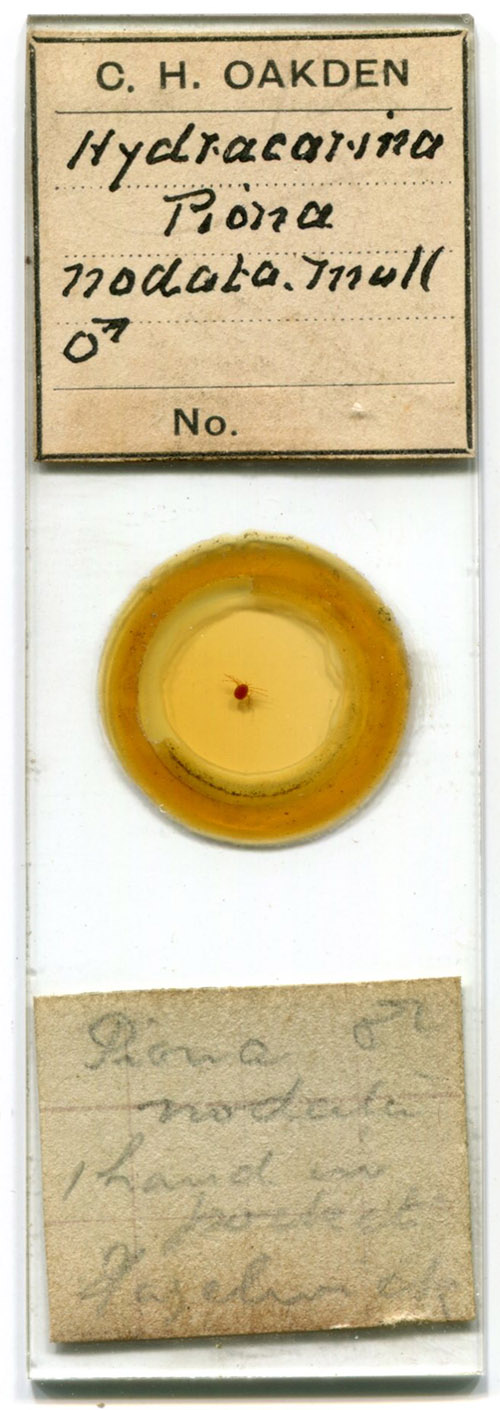
Figure 1.
A C.H. Oakden slide of a male Piona nodata water mite (“hydracarina”). It probably dates from Oakden’s initial period of microscopical enthusiasm, between ca. 1888 - ca. 1892. While he had a second period of interest in microscopy, beginning ca. 1920, he was then a Fellow of the Royal Microscopical Society, and it was customary for Fellows to use the initials F.R.M.S. with their names (lacking on this slide).
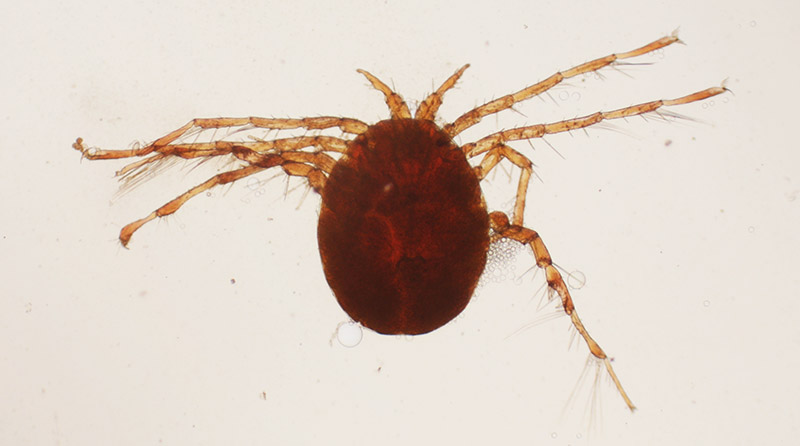
Figure 2.
A male Piona nodata, prepared by Charles H. Oakden (see Figure 1).

Figure 3.
An 1889 exchange offer from “Hardwicke’s Science-Gossip”.
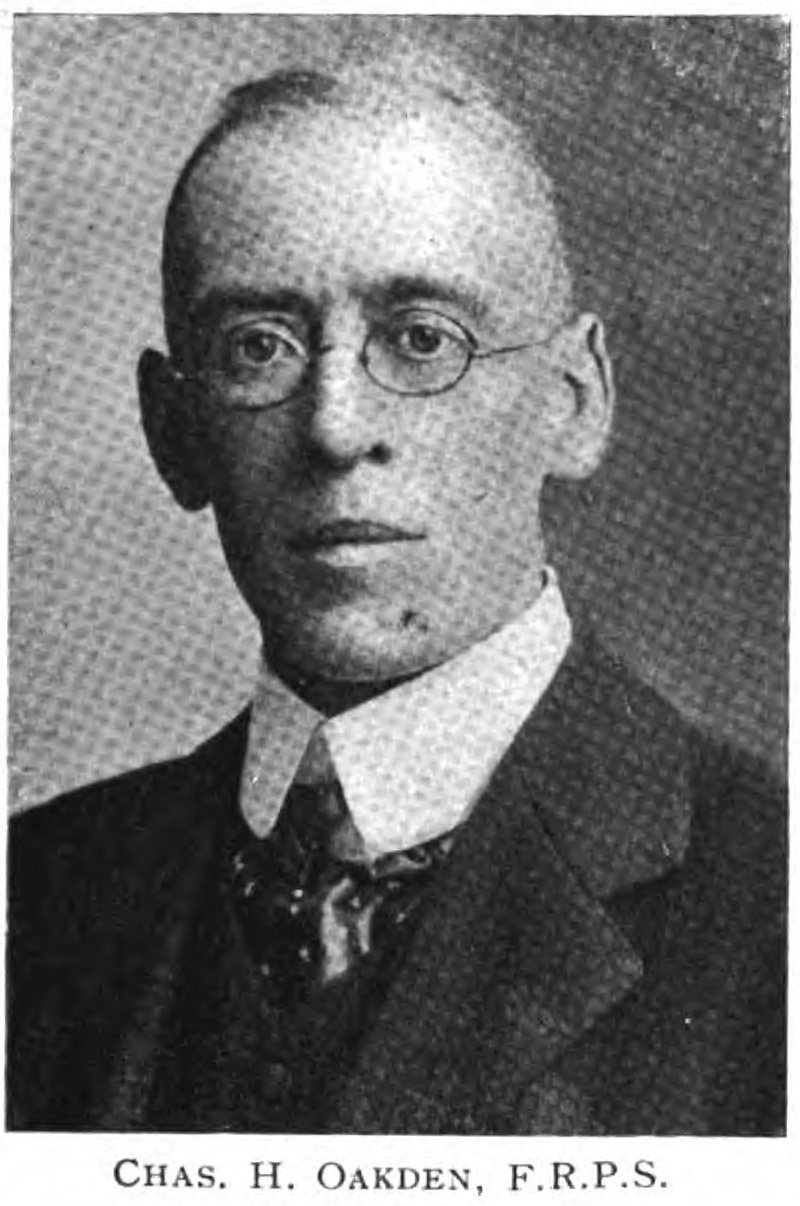
Figure 4.
Charles Henry Oakden, from a 1907 article in “The Photographic News”. If the photograph was current, he was then 48 years old.
Charles Henry Oakden was born in early 1859, in Camberwell, Surrey (south of the Thames River from London, now part of metropolitan London). He was the eldest child of Daniel and Ann Oakden. Father Daniel drove a horse-drawn taxi. Charles and his younger siblings all attended school until at least 12-14 years of age, an education that permitted Charles to follow a career as a clerk.
Charles married Louisa Hamblett in 1881. They had one child, Louisa Dorothy, in 1898. The Oakdens lived a fairly comfortable life; for example, the 1881 census showed that they employed a live-in servant.
Charles Oakden joined the Quekett Microscopical Club on December 28, 1888. He then lived in East Dulwich, near Camberwell. In the spring of 1889, he published a request to obtain specimens of parasites (Figure 3). That November, he attended the Annual Soiree of the Croydon Microscopical & Natural History Club.
On April 30, 1890, Oakden exhibited a specimen of the water mite Arrenurus caudalus at a conversazione of the Royal Microscopical Society. He appears to have been a visitor, as records of the following several years do not note him as “F.R.M.S.”.
Oakden is listed as a member of the QMC in the 1891 membership list, but does not appear in the 1894 or subsequent lists of the nineteenth century.
Oakden then turned his attention to photography. He was associated with several clubs, served as President of the South London Photographic Society, and was elected as a Fellow of the Royal Photographic Society. His specialty appears to have been architectural photography. Among his honors, Oakden’s photograph “Across to Retro-Choir, Winchester Cathedral” was selected as a “Photogram of the Year” for 1898 (Figure 5). Another photograph of Winchester Cathedral was featured in The Photographic News, 1907, as “My Best Picture” (Figure 6).
There was a resurgence of interest in microscope around 1920. On March 9, 1920, Oakden re-joined the QMC, and on November 20, 1920, he became F.R.M.S.
At a 1922 joint meeting of the RMS and QMC on “pond life”, Oakden showed a slide of Arrhenurus crassipetiolatus water mites.
In 1926, Oakden gave a presentation to the RMS on “Joseph Bancroft Reade: his contributions to microscopical science”. This was published that year in the Journal of the Royal Microscopical Society.
Oakden was elected to serve on the Council of the Quekett Microscopical Club in 1927.
He made two notable presentations to the QMC, both of which were published in the Club’s Journal: “The invention of the micropolariscope and its early applications” (April 17, 1928), and “Various forms of photomicrographical apparatus” (June 11, 1929).
Charles’ wife, Louisa, died in early 1933. Their daughter, Dorothy, remained unmarried and continued to live with Charles.
Oakden is listed in the 1936 membership roll of the QMC, but not the 1939 list. He died on December 8, 1940, in Abbots Langley, Hertfordshire, where he was presumably on vacation.
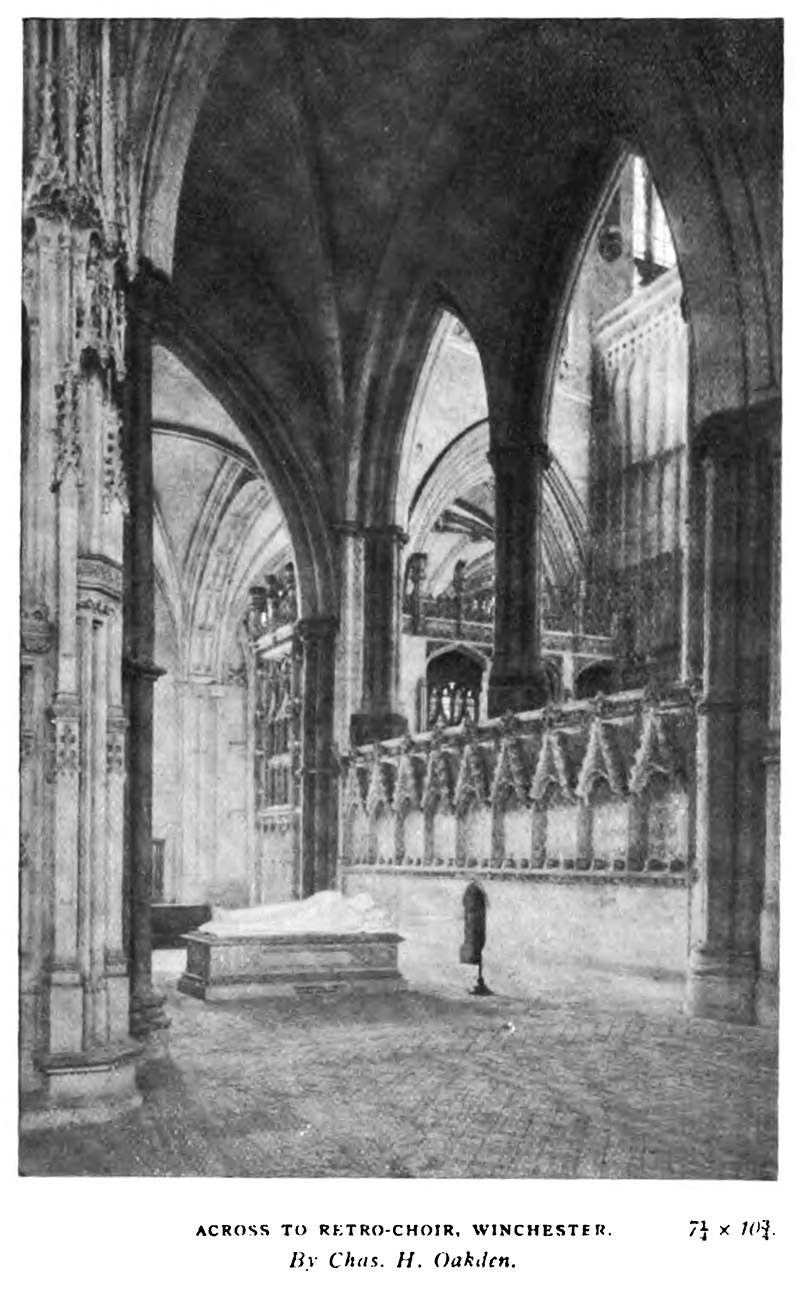
Figure 5.
“Across to Retro-Choir, Winchester”, by Charles Oakden. This was selected as a “Photogram of the Year”, 1898.
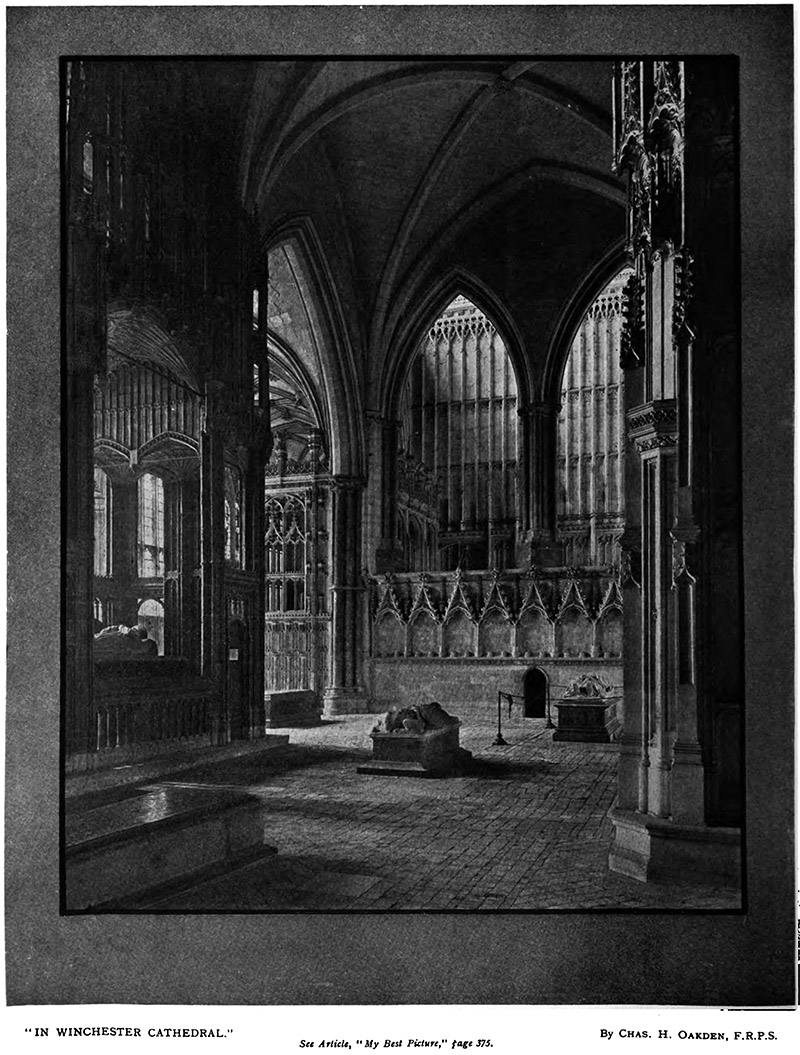
Figure 6.
“In Winchester Cathedral”, by Charles H. Oakden. This image was featured in “The Photographic News”, 1907.
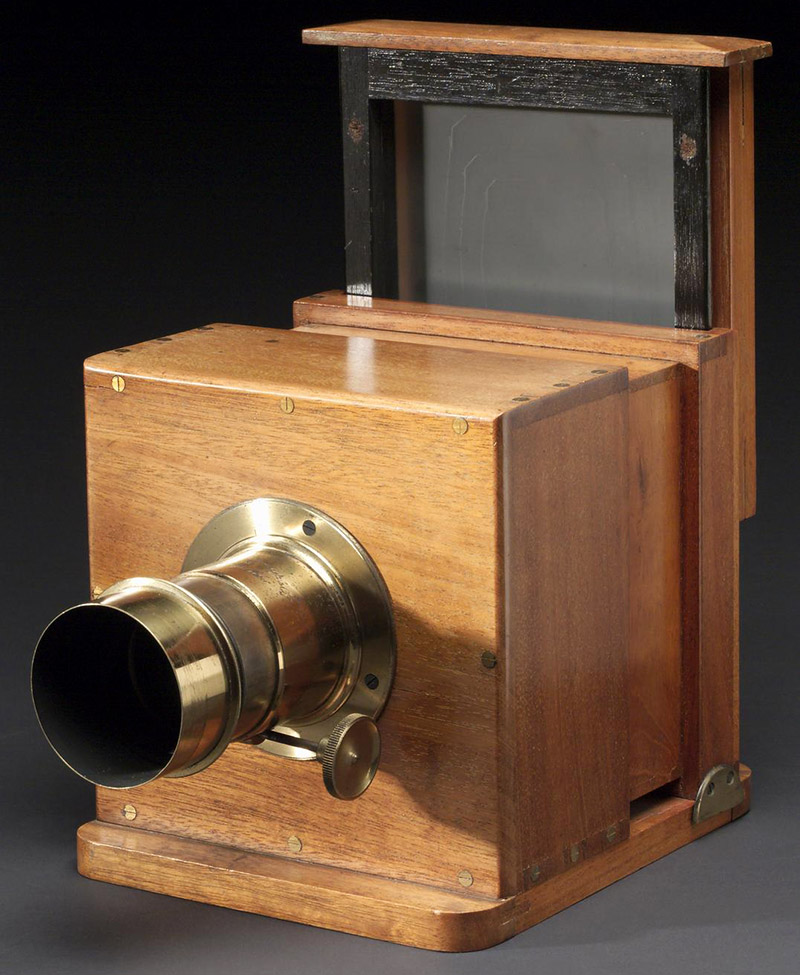
Figure 7.
A camera that was donated by C.H. Oakden to the Science Museum, described as “Dry collodion plate camera, sliding box, c. 1860, with lens by London Stereoscopic Co.” Adapted for nonprofit, educational purposes from https://collection.sciencemuseumgroup.org.uk/objects/co15035/dry-collodion-plate-camera-plate-camera.
Resources
England census and other records, accessed through ancestry.com
Hardwicke's Science-Gossip (1889) Exchange offer from C.H. Oakden, Vol. 25, page 72
Journal of the Quekett Microscopical Club (1892) “Members … Dec. 28, 1888. Oakden, C.H., 51, Melbourne grove, East Dulwich, S.E.”
Journal of the Quekett Microscopical Club (1894) C.H. Oakden not listed as a member
Journal of the Quekett Microscopical Club (1927) Officers and Committee, elected February, 1927
Journal of the Quekett Microscopical Club (1933) “Members … Mar. 9, 1920. Oakden, Chas. H., F.R.M.S., 30 Meadow Road, Shortlands, Kent”
Journal of the Quekett Microscopical Club (1936) “Members … Mar. 9, 1920. Oakden, Chas. H., F.R.M.S., 30 Meadow Road, Shortlands, Kent”
Journal of the Quekett Microscopical Club (1939) C.H. Oakden not listed as a member
Journal of the Royal Microscopical Society (1890) Report of the April 30 Conversazione, pages 683-684
Journal of the Royal Microscopical Society (1920) new Fellows, page 121
Journal of the Royal Microscopical Society (1922) “Pond Life Exhibits were shown by the following Fellows of the Society and Members of the Quekett Microscopical Club ... C.H. Oakden, F.R.M.S. - Water Mites , Arrhenurus crassipetiolatus”, page 444
Oakden, Charles H. (1926) Joseph Bancroft Reade: his contributions to microscopical science, Journal of the Royal Microscopical Society, Vol. 46, pages 181-192
Oakden, Charles H. (1928) The invention of the micropolariscope and its early applications, Journal of the Quekett Microscopical Club, page 75
Oakden, Charles H. (1929) Various forms of photomicrographical apparatus, Journal of the Quekett Microscopical Club, page 195
Photograms of the Year (1898) page 12
The Photographic News (1897) Report of the annual dinner of the Hackney Photographic Society, Vol. 41, page 158
The Photographic News (1898) Report of the Dulwich Photographic Society’s Exhibition, Vol. 42, page 42
The Photographic News (1898) Report of a meeting of the South London Photographic Society, Vol. 42, page 77
The Photographic News (1907) My best picture and why I think so, Vol. 52, pages 366 and 375
Probate of the will of C.H. Oakden (1940) “Oakden Charles Henry of 30 Meadow-road Shortlands Kent died 8 December 1940 at Abbots Langley Hertfordshire Probate Llandudno 22 April to Louisa Dorothy Oakden spinster. Effects £1805 15s”, accessed through ancestry.com
Proceedings and Transactions of the Croydon Microscopical & Natural History Club (1889) Annual Soiree, page cxx






